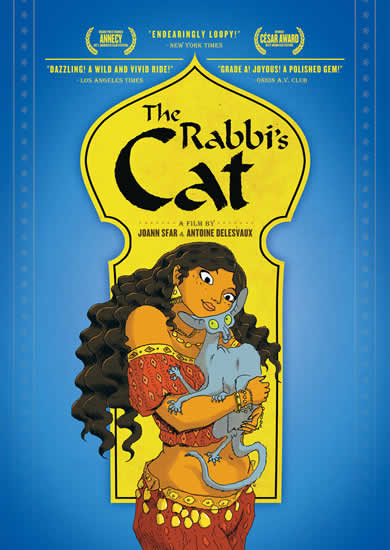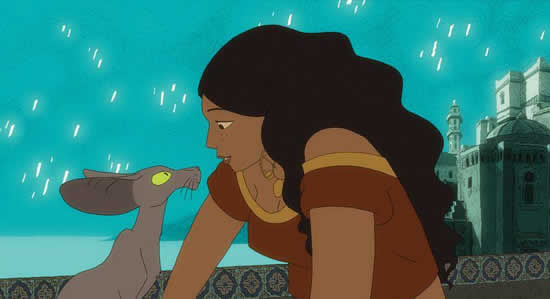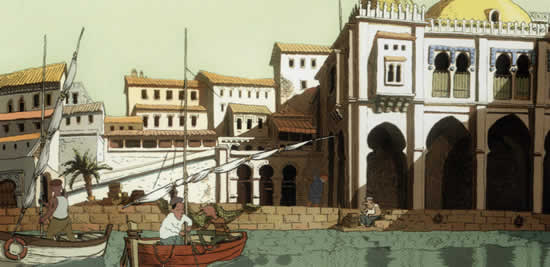 Joann Sfar and Antoine Delesvaux’s quirky “The Rabbi’s Cat”, based on volumes of Sfar’s ‘bandes dessinées’ received two nominations at the 40th Annie Awards (Best Animated Feature and Outstanding Achievement, Directing in an Animated Feature Production.) Set in 1920’s Algeria, the author-driven flat animation owes its adult material and multicultural cool to Sfar’s love for the Fleischer Studio’s pre-code Betty Boop, Out Of The Inkwell-Koko The Clown etc..)
Joann Sfar and Antoine Delesvaux’s quirky “The Rabbi’s Cat”, based on volumes of Sfar’s ‘bandes dessinées’ received two nominations at the 40th Annie Awards (Best Animated Feature and Outstanding Achievement, Directing in an Animated Feature Production.) Set in 1920’s Algeria, the author-driven flat animation owes its adult material and multicultural cool to Sfar’s love for the Fleischer Studio’s pre-code Betty Boop, Out Of The Inkwell-Koko The Clown etc..)
A title sequence of cursive silhouettes recalls Fritz Freleng’s Pink Panther title sequences. animation. “The Rabbi’s Cat”, a colorful brew of Colonialism, biblical debate, magical realism and adventure, won the Annecy Crystal for best feature at the 2011 Annecy International Animated Film Festival and the 2012 César for best animation.
The opinionated no-named cat (François Morel) simply known in the Casbah as the Rabbi’s Cat, is a sarcastic companion. The pet of the widowed Sephardic Rabbi Sfar (Maurice Bénichou) dotes on his mistress, the Rabbi’s voluptuous daughter Zlabya, (Hafsia Herzi), whose name trips off his feline tongue like ” a honeyed pastry”. He puts up with her annoying sharp-nosed girlfriend Knidelette (Alice Houri) just to sleep on her downy breast and watch her earthy sashay. And she dotes on the cat even before he can speak.
The sardonic hairless Abysinnian eats the annoying family parrot (Olivier Broche) and gains the power of speech. Happily so, as the one-liner flipping feline is our narrator. Astonished at her pet’s ability, Zlabya convinces her father that the cat can speak. What follows is a mélange of witty discourse on love, lust, religious tolerance, death and, yes, even “zoophilia”.
“Did you eat my parrot?” grills the Rabbi. “No” lies the cat with the first words out of his mouth, leading the Rabbi and his strict teacher to label the sophistic pet a spawn of Shaitan, a murderer and a liar. “I am the lord your God come in disguise as a cat to test you” the cat counters. Discovering the talented feline reading Stendhal’s racy “The Red and The Black” to his well-guarded daughter, Rabbi Sfar forbids her to ever see her cat alone.
The quarrelsome cat is a fur ball of contradictions, self-serving but generous, dismissive and philosophical, possessive of his mistress and master, a hedonistic homebody yet eager for adventure.
The cat, who’s picked up a lot of scientific knowledge before he could speak, dismisses Genesis as “absurd… Even a kitten wouldn’t fall for such idiocy.” Carbon dating proved the world lasted thousands of years. Adam and Eve, he rejects as a symbol. “The truth is prehistoric man.” In fact he argues for scientific rationalism at every turn.
“Am I a Jew?” he wonders, “I’ve never been circumcised”. In love with Zlabya, and determined to be considered a full member of the Rabbi’s family, he asks to study the mystical Kabalah, for his Bar Mitzvah. The Rabbi takes the cat to his own Rabbi (Daniel Cohen) for counsel. Showing off the cat only offends his conservative teacher who suggests they kill the cat for his offensive remarks.
Most amusing, we see one of the cat’s dreams (drawn in an amusing childlike style). Before he had words he had simple dreams, he explains. He chased small animals. Now he suffers anxious existential dreams about losing his mistress and frets over his master’s depression. The Rabbi becomes a cat. The cat and the transformed Rabbi roam the street scavenging food, but when the cat gives him lessons in mounting a female cat, the Rabbi-cat refuses.
Rabbi Sfar is troubled. He’s been asked to take a French “Dictée”, to be awarded a certificate as a Rabbi from the French home government. ” You pray in Hebrew for Arab-speaking Jews and they want you to write in French” counsels the chatty cat, offering to take the test for him master. Shut out of the testing room, the cat calls on God’s intercession and is smote speechless for taking the Lord’s name in vain.
It’s a pleasure to bask in the varied flat animation styles; especially the Rabbi’s ornately decorated home. Sfar’s style of lush arabesques captures the lovely atmosphere of colonial Algiers, redolent with plashing fountains, cafes and ports. The cat loses it’s power of speech half way through (I really missed his repartee) and the film veers off to a Saharan road trip in search of a legendary African Jerusalem, a supposed Utopian home of the Ethiopian Black Jews.
In the French Colonial town of Algeria, the Jews and Muslims are considered second-class citizens. The Rabbi, who’s chased away from the a popular French Colonial cafe, waits for his cousin, the sun- bleached blue-eyed Malka of the Lions (the great Jean-Pierre Kalfon-“L’amour fou”). Striding down the street with his pet lion, Malka insures they are served as, all around them, clients scatter.
Easy going humorous Rabbi Sfar joins another cousin, Sufi Sheik Mohammed Sfar (Mohamed Fellag) in an annual desert pilgrimage to the tomb of the Sufi saint Messaoud Sfar. The two old friends dance in silhouette in the moonlight in a charming sequence.
Mohammed Sfar’s donkey speaks and sings (out of key) in three languages, one of which he uses to argue with the cat.
When a box of Jewish books arrives from Russia, the Rabbi’s family discovers a Jewish painter stowed away to escape a pogrom. While The Rabbi argues with his Rabbi about whether or not to bury the body as a Jew, a Russian Jew or a Christian, the cat awakes him. Though the cat and the Painter can understand each other, no one else can understand the cat.
 Zlabya’s entranced by the revived painter (Sava Lova), himself in search of a debauched Russian Orthodox adventurer Vastenov (Wojciech Pszoniak). The Rabbi finds the drunken madman in a decommissioned Russian Orthodox church praying for the dead Czar.
Zlabya’s entranced by the revived painter (Sava Lova), himself in search of a debauched Russian Orthodox adventurer Vastenov (Wojciech Pszoniak). The Rabbi finds the drunken madman in a decommissioned Russian Orthodox church praying for the dead Czar.
Vastenov translates for the painter. His story of escaping a program to stow away (and the final adventure in the hidden city) are animated in a spindlier style reminiscent of Fritz Freleng or Chuck Jones’ Wiley Coyote. The rest of the charming cartoon’s sensual style tips its hat at Herge’s Line Claire.
The men repair to the baths. The painter’s plans to travel to the land of the Black Jews stirs up a conversation rife with colonial racism of all stripes.
Sent by the Jewish Agency, who is looking for a safe exile for the Russian Jews, he’s in search of the descendants of Solomon and Queen Sheba, the Falasha, who speak Aramaic and practice strict Judaism.
Vastonov offers his magnificent automobile, a 1925 Citroen half-track, the legendary vehicle used in the Citroën Central African Expedition of 1924-25.
Rabbi Sfar, Mohammed Sfar, the painter and the aristocratic Vastenov joined by the cat and donkey, travel the desert and jungle. Their desert adventure recalls Indiana Jones and Tintin. There’s a Tintin and Snowy cameo, satirizing Tintin as a patronizing enthnocentric twit.
The cat is bit by a scorpion. To save him they visit a nomadic tribe near the desolate Tanezrouft seeking help from their marabout. The marobout’s magic heals the cat and restores his speech. But a religious argument with one of warriors of the Tribe ends in violence. (This sequence, the cat’s obsession with the sensual Zlabya and the text really make this an adult film.)
The meet an African bar maid, who marries the painter, and a Colonial painter who uses phrenology to substantiate his racism. Even the Black Jews in the fabled town are racist.
The humanist film, which in image, text and characters espouses religious tolerance and social harmony, is best expressed by the Sufi Sfar “My God isn’t full of hate. He loves the sciences and arts. He’s never happier than when his children are at peace. It’s a pity he lets so many fools speak in his name.”
The visionary animation distributer Gkids picked it up. They have become the one stop shop for flat animation alternatives to the brash CG Hollywood animated features. Distributed in both 2 and 3D
Joann Sfar’s previous live action “Gainsbourg, Une Vie Heroique” used a fantastic alter ego to question singer-songwriter Gainsbourg’s identity crisis. Sfar’s discursive meandering style is found in his many Graphic novels “Vampire Loves”, “Klezmer”, “The Professor’s Daughter” (in collaboration with Emmanuel Guibert), the “Sardine in Outer Space” and “Little Vampire” series. He’s produced over 100 books since the early 1990s.

